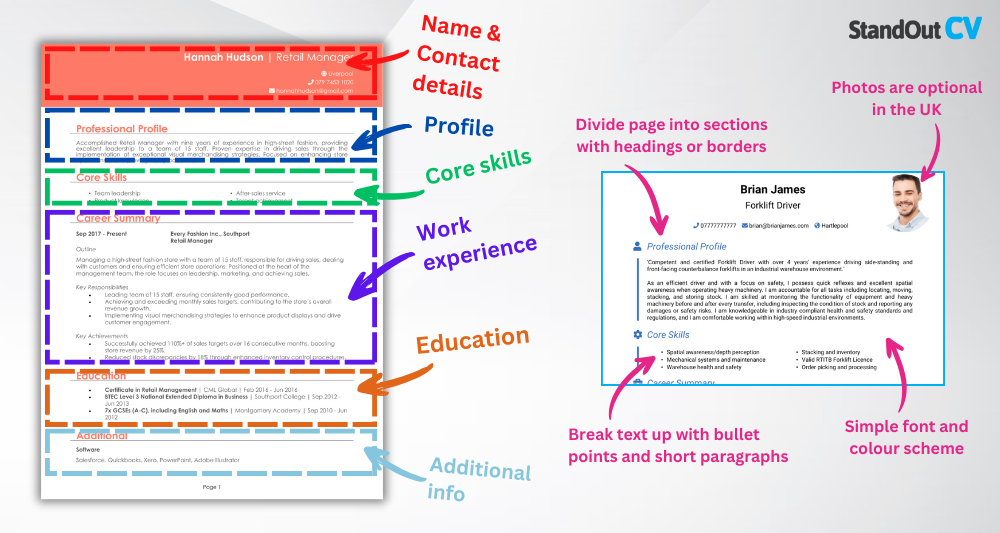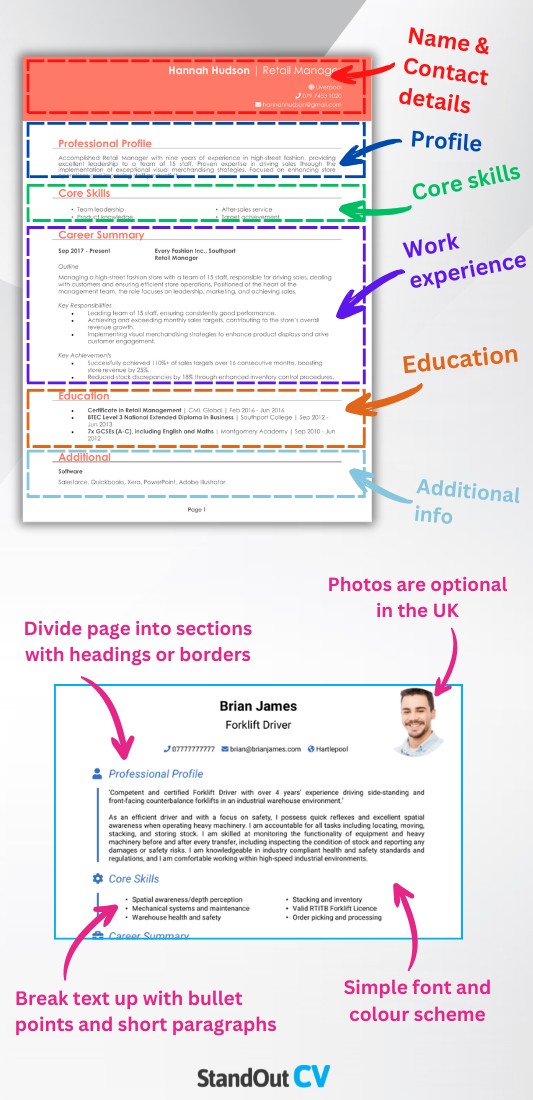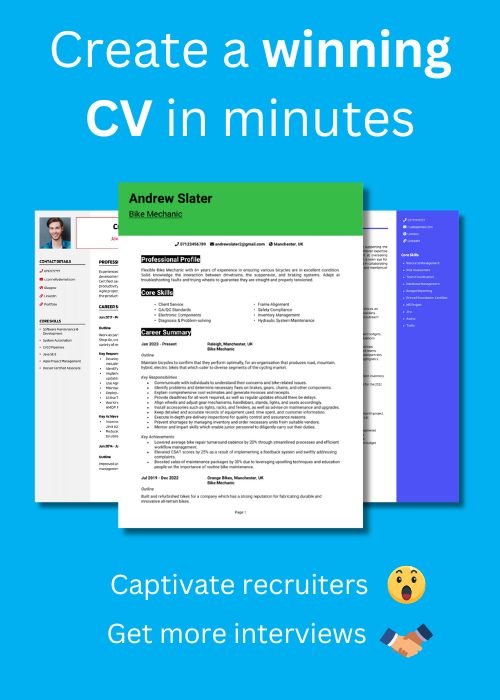Keeping buildings comfortable year-round and ensuring systems run efficiently – it’s all in a day’s work for a skilled HVAC engineer. But getting hired takes more than technical know-how; you’ll need a CV that shows hiring managers you can handle the job’s demands from day one.
With a HVAC Engineer CV example, this guide will walk you through how to create an application that highlights your expertise, qualifications, and the value you bring to any and all projects.
HVAC Engineer CV sample

How to write your HVAC Engineer CV
Discover how to craft a winning HVAC Engineer CV that lands interviews with this simple step-by-step guide.
Much like a well-built HVAC system, your CV needs to be efficient and reliable. With the right structuring and clear content, it becomes effortless for employers to see you have the skills, certifications, and practical experience they’re looking for.
In the sections ahead, you’ll learn how to write a CV to showcase your achievements and tailor your application so that you’re the obvious choice for the role.
How to structure and format your HVAC Engineer CV


An effective CV is like a well-planned installation – everything in its place, working together without wasted space. A good structure ensures recruiters can quickly locate the details they need, whether that’s your qualifications, work history, or specialist areas of expertise. Making the mistake of a messy application will only encourage readers to move onto the next one.
Here’s the layout to follow:
- Name and contact details – Ensure your name and personal details are easily visible at the top. A photo is optional and depends on the role.
- Profile – Craft a short introduction that showcases your professional background and key accomplishments.
- Core skills – Provide a quick overview of your top skills that show why you’re a great fit.
- Work experience – Outline your career progression in reverse order, emphasising your contributions and successes.
- Education – Provide details on your academic background, including certifications or specialised training.
- Additional info – You can add hobbies or activities here that reflect your enthusiasm for the industry.
When it comes to formatting, keep it professional and easy to read. Use bullet points to break up dense information and add clear headings for each part of your CV. Opt for a clean, business-appropriate font. Keep the total length to two pages or less, and make good use of white space so your CV format feels well-structured and approachable.
How to write a HVAC Engineer CV profile


Your professional profile is where you sell yourself as the perfect fit for the role. It should introduce your background, summarise your key strengths, and clearly show the value you’d bring to a new employer.
Beyond your technical skills, highlight your ability to complete projects to a high standard and keep systems running smoothly, all with the aim to ensure compliance with safety regulations.
HVAC Engineer CV profile examples
Profile 1
Experienced HVAC Engineer with over 15 years in commercial and industrial projects, specialising in the installation, maintenance, and optimisation of large-scale heating, ventilation, and air conditioning systems. Skilled in conducting site surveys, preparing technical drawings, and ensuring compliance with health and safety regulations. Proficient in AutoCAD, BMS systems, and diagnostic tools. Recognised for delivering reliable solutions that reduce energy consumption and improve system performance.
Profile 2
Skilled HVAC Engineer with eight years of experience in residential and commercial property maintenance. Adept at installing, repairing, and servicing HVAC systems while responding to urgent breakdowns. Familiar with using HVAC design software and digital maintenance logs to streamline operations. Known for strong problem-solving abilities and excellent client communication, ensuring systems are safe, efficient, and cost-effective.
Profile 3
Motivated HVAC Engineer with three years of experience working for a building services contractor. Supported senior engineers with installations, routine servicing, and performance testing of air conditioning units and ventilation systems. Comfortable reading blueprints, completing maintenance reports, and ensuring compliance with industry standards. Committed to developing technical expertise and delivering high-quality service.
Details to put in your HVAC Engineer CV profile
Here’s what you should include in your HVAC Engineer CV profile:
- Where you worked – Briefly state the types of environments and organisations you’ve worked in, such as commercial buildings, residential developments, or industrial sites.
- Your top qualifications – Mention any certifications, licences, or formal training that support your expertise in HVAC systems.
- Essential skills – Explain the core capabilities you bring, keeping them relevant to the role and industry standards.
- Projects or systems handled – Outline the scale and type of HVAC installations, repairs, or maintenance you’ve undertaken.
- Value delivered – Demonstrate how your work has improved efficiency, reduced downtime, or saved costs for clients or employers.
What to include in the core skills section of your CV


The CV skills section acts as a quick snapshot of your strongest capabilities, allowing recruiters to immediately see that you meet the job’s technical demands. Focus on hard, tangible skills that match the job description, as these are often the first things hiring managers scan for.
Tailoring this section to each application is essential – it ensures you’re always presenting the most relevant skills for that particular employer and project scope.
What are the most important skills for a HVAC Engineer CV?
- Heating and Cooling System Design – Creating specifications and layouts for HVAC systems in residential, commercial, or industrial buildings.
- Installation and Commissioning – Setting up HVAC equipment and ensuring proper operation through system testing and calibration.
- System Troubleshooting and Diagnostics – Identifying faults in heating, ventilation, or cooling systems and applying effective repair solutions.
- Preventive Maintenance Planning – Conducting routine inspections and servicing to extend equipment lifespan and maintain efficiency.
- Load Calculations and Energy Efficiency Analysis – Performing thermal load assessments to determine system requirements and optimise performance.
- Control Systems Integration – Installing and configuring thermostats, sensors, and automation systems for climate control.
- Compliance with Codes and Standards – Ensuring all installations and repairs meet local regulations and industry standards such as ASHRAE or F-Gas.
- Refrigerant Handling and Recovery – Managing refrigerants in line with environmental regulations and safety procedures.
- Ductwork Fabrication and Design – Designing and modifying duct systems for optimal airflow and minimal energy loss.
- Technical Documentation and Reporting – Preparing job reports, service records, and equipment specifications for clients and regulatory purposes.
How to write a strong work experience section for your CV


This is the most important part of your CV, showing exactly how you’ve put your skills into practice. Employers want to see proven results, an ability to handle varied systems, and a track record of meeting deadlines without compromising quality.
Go over your work experience in reverse chronological order, starting with your most recent. For each role, give a brief overview of the employer and your position, then use bullet points to set out your main responsibilities and achievements.
The best way to structure job entries on your CV

- Outline – Summarise the type of organisation you worked for, your role, and the overall purpose of your position. Include who you reported to or worked alongside.
- Responsibilities – Detail the work you carried out, using action words like “installed” and “maintained”. For example: “installed energy-efficient heating systems” or “maintained large-scale air conditioning units in commercial premises.”
- Achievements – A useful tip is to quantify your impact wherever possible, such as reducing system downtime, improving energy efficiency, or delivering projects under budget.
Sample jobs for HVAC Engineer
HVAC Engineer | Ashcroft Mechanical Services
Outline
Delivered installation and maintenance of HVAC systems for a large facilities management provider working with commercial office buildings across London. Ensured compliance with industry standards while providing efficient client service.
Responsibilities
- Installed and commissioned commercial heating, ventilation, and air conditioning units
- Completed routine servicing and fault-finding on HVAC equipment
- Produced maintenance reports and updated digital asset management systems
- Responded to emergency call-outs and resolved breakdowns in a timely manner
- Worked alongside electricians and plumbers to coordinate building services
Achievements
- Reduced system downtime by 25% through proactive maintenance scheduling
- Achieved client energy savings of £50k annually by optimising system settings
- Contributed to a successful ISO 14001 audit by ensuring compliance documentation
HVAC Engineer | Nexora Property Solutions
Outline
Worked for a regional property services company providing HVAC installation and servicing across residential apartment blocks and retail spaces. Delivered safe and reliable solutions to meet client requirements.
Responsibilities
- Assessed client requirements and recommended appropriate HVAC solutions
- Installed split-type and ducted air conditioning systems in residential complexes
- Performed routine checks on boilers, chillers, and ventilation equipment
- Documented service history using digital job tracking systems
- Communicated technical findings clearly to tenants and property managers
Achievements
- Improved first-time fix rates by 20% through accurate fault diagnosis
- Introduced a reporting template that cut paperwork time by 30%
- Recognised with an internal award for outstanding customer service
HVAC Engineer | Greenwave Building Services
Outline
Supported installations and maintenance for a building services contractor specialising in sustainable developments. Assisted with technical drawings, system checks, and site inspections for HVAC projects in new housing and small commercial builds.
Responsibilities
- Assisted senior engineers with installation of energy-efficient HVAC systems
- Read and interpreted technical drawings and wiring diagrams
- Monitored performance of ventilation systems and conducted airflow tests
- Prepared site reports and logged test results for quality assurance
- Followed health and safety procedures and completed risk assessments
Achievements
- Helped deliver three housing developments with sustainable HVAC solutions
- Contributed to a 15% improvement in installation efficiency through better site prep
- Supported project bids by preparing accurate technical documentation
How to list your educational history


While HVAC roles often rely heavily on practical experience, qualifications and certifications are crucial for proving your technical knowledge and compliance. This may include education like apprenticeships, industry-recognised certificates, or further study in engineering disciplines, such as any degrees.
List your qualifications in reverse chronological order, starting with the most recent. Include any specialist training or safety certifications that directly support your work as an HVAC engineer.
What are the best qualifications for a HVAC Engineer CV?
- Level 3 NVQ Diploma in Heating, Ventilation and Air Conditioning Maintenance – Proves technical skills for maintenance and installation.
- City & Guilds 6187-21 Plumbing Studies – Adds valuable cross-disciplinary knowledge for system integration.
- F-Gas Certification – Required for working with fluorinated gases in refrigeration and air conditioning systems.
- Level 3 Diploma in Electrical Installations – Supports electrical competency in HVAC systems.
- Health and Safety in the Workplace Certificate – Demonstrates awareness of workplace safety regulations.





